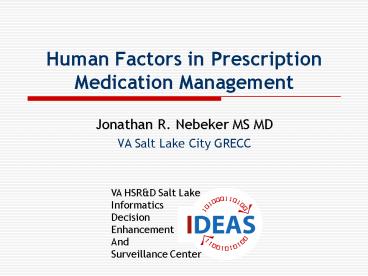Human Factors in Prescription Medication Management - PowerPoint PPT Presentation
1 / 25
Title:
Human Factors in Prescription Medication Management
Description:
VA Salt Lake City GRECC. Acknowledgements. Charlene R. Weir, PhD. Frank Drews, PhD ... VA Salt Lake City GRECC. VA Salt Lake City IDEAS Center. 2. Overview ... – PowerPoint PPT presentation
Number of Views:65
Avg rating:3.0/5.0
Title: Human Factors in Prescription Medication Management
1
Human Factors in Prescription Medication
Management
- Jonathan R. Nebeker MS MD
- VA Salt Lake City GRECC
2
Acknowledgements
- Charlene R. Weir, PhD
- Frank Drews, PhD
- Molly Leecaster, PhD
- Rand Rupper, MPH MD
- Kenneth Boockvar, MD
- Brittany Mallin, MS MPH
- AHRQ R18 HS017186
- VA Salt Lake City GRECC
- VA Salt Lake City IDEAS Center
3
Overview
- The Electronic Health Record context
- Current
- Future
- How theory gets us to future
- Theoretical Framework
- Study design
- Preliminary Findings
4
Current CPRS VistA
- Emphasis on access
- Information siloed in tabs
5
Future CPRS VistA
- Emphasis on control
- Information integrated
6
Goal EHR of future
7
Decision Support v. Sense Making
- Computerized decision support is typically
normative and targets the right decision. - The CPRS of the future will emphasize an
information-rich environment that targets sense
making to support higher quality decisions in the
highly variable context of patient care.
8
Progress
- The Electronic Health Record context
- Theoretical Framework
- (The pathway to the future)
- Joint Cognitive Systems or Cognitive Systems
Engineering - Contextual Control Model
- Study Design
- Preliminary Findings
9
Towards the Future
- Apply Cognitive Systems Engineering
- Human Factors in this talk
- Not about usability
- About the human-computer system
10
Joint Cognitive Systems
- Erik Hollnagel and David Woods
- System of artifact(s) human(s) that
accomplishes work. - Not what do human and computer do best
- Control is a measure of the works quality.
- Examples of JCS
- Scissors
- Fighter jets
- Combat robots
11
Contextual Control Model (CoCoM)
- Performance in context
- Different types of behaviors predict better
outcomes - Functional not structural approach
- Not about information processing models Memory,
programs, etc. - Used in engineered systems
- ABS at Saab
- Nuclear Power Plants
12
CoCoM Main Concepts
- Competencies possible actions in context
- Constructs assumptions about situation
- Control modes characteristics of performance
that govern quality of performance - Feed forward and feedback anticipatory versus
reactive control
13
Control Cycle in Healthcare
14
Control Modes
- Scrambled
- Lack of purposeful activity
- Opportunistic
- Addressing salient characteristics
- Tactical
- Following procedure, limited scope
- Strategic
- Broader scope and higher-level goals
15
Control Characteristics
- Goal Complexity (Number and Interaction)
- Perceived Time Pressure
- Evaluation of Outcome
- Selection of Action
- Expertise
- Motivation
- Familiarity
16
Progress
- The Electronic Health Record context
- Joint Cognitive SystemsContextual Control Model
- Study Design
- Preliminary Findings
- Control characteristics
17
Study Goals
- Immediate Aim
- Translate CoCoM to medication management for
chronic diseases - Explore associations between control
characteristics and surrogate outcomes - Next Aim
- Establish validity of adapted CoCoM control
characteristics as predictor of higher quality
outcomes through simulation
18
Study Design
- Subjects 40-50 physicians, mid-levels,
residents, nurses, pharmacists in 5 outpatient
clinics/4 states. Focus on HTN - Think-aloud protocol Interview
- Saturation coding for control characteristics
- Content analysis
- Multi-dimensional scaling
19
Preliminary Findings
- Semi-Qualitative
- Stories of control modes
- Scrambled
- Opportunistic
- Tactical
- Strategic
20
Scrambled Mode
- Type Trial and error performance
- Case of the new intern and forgetful patient.
- Low information quality and availability
- Low experience
21
Opportunistic Mode
- Type Reaction to salient characteristics
- Have not seen yet for HTN
- Reaction to SBP only
- Pain syndromes even among experienced
- Poor construct of problem
- Low information quality
- Vague goals difficult to resolve competition
- Vague evaluation of outcome not mentioned, then
OK.
22
Tactical
- Type Following procedure
- Dominant mode for HTN
- Use of protocol
- Focus on procedure (forget clinical goal)
- Minimal consideration of interacting goals
- Low use of feed-forward control
- Problem with information quality-clinical inertia
- Less common in highly experienced MDs
23
Strategic
- Type Broad consideration of context
- Almost exclusively with experienced MDs
- Awareness of protocols but deviation to
accomplish conflicting patient goals - Familiarity with past therapy a key factor
- Feed forward strategies account for physiologic
and organizational factors - Still, incomplete use of explicit control limits
24
Conclusions
- CoCoM reveals interesting characteristics of
system performance. - High-mode characteristics have face validity for
predicting better outcomes. - Implications for software design
- Need to support efficient, rich reconstruction of
mental model of patient - Need to highlight interaction of goals and
therapies - Need to increase time horizon including feed
forward
25
(No Transcript)































